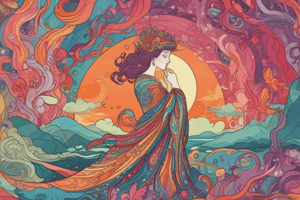Podcast
Questions and Answers
What determines the value of a color?
What determines the value of a color?
- The saturation of the color
- The position on the color wheel
- The brightness and darkness of the color (correct)
- The hue of the color
Which term describes colors that are adjacent to each other on the color wheel?
Which term describes colors that are adjacent to each other on the color wheel?
- Complimentary colors
- Contrasting colors
- Analogous colors (correct)
- Harmonious colors
What effect do complimentary colors have when mixed?
What effect do complimentary colors have when mixed?
- They blend seamlessly
- They enhance color brightness
- They create a lighter shade
- They produce grey (correct)
How can you describe 'tone' in terms of color?
How can you describe 'tone' in terms of color?
Which colors are classified as warm colors on the color wheel?
Which colors are classified as warm colors on the color wheel?
What should be used to counteract purple circles under the eyes?
What should be used to counteract purple circles under the eyes?
Which of the following color characteristics refers to being non-permeable by light?
Which of the following color characteristics refers to being non-permeable by light?
What happens to the predominant color when a small amount of one contrasting color is added to it?
What happens to the predominant color when a small amount of one contrasting color is added to it?
Flashcards
Value
Value
The lightness or darkness of a color.
Intensity
Intensity
The purity or intensity of a color, how vibrant or dull it appears.
Analogous Colors
Analogous Colors
Colors that are next to each other on the color wheel, creating harmonious blends.
Complementary Colors
Complementary Colors
Signup and view all the flashcards
Tone
Tone
Signup and view all the flashcards
Transparent
Transparent
Signup and view all the flashcards
Translucent
Translucent
Signup and view all the flashcards
Opaque
Opaque
Signup and view all the flashcards
Study Notes
Color Theory
- Value: Low value colors are dark, high value colors are light. An intense yellow is high in value, but an intense purple is low in value.
- Intensity: Colors can have different intensities (strength) and values (lightness/darkness) but be the same color.
- Color Wheel: The color wheel helps with color mixing. Colors close together on the wheel are harmonious (analogous). Colors opposite each other are complementary and create a dramatic blend when mixed. Mixing complementary colors will create gray.
- Analogous Colors: Adjacent colors on the color wheel.
- Complementary Colors: Colors opposite each other on the color wheel.
- Tone: A hue with gray added. Tones vary in shades from black to white.
- Transparent: Impenetrable to light.
- Translucent: Semi-permeable to light.
- Opaque: Non-permeable to light.
- Color Temperature: Warm colors (red, yellow) and cool colors (blue, purple).
- Makeup Applications: Using contrasting colors can correct problems. Orange to cancel blue circles under eyes. Green for redness (cheek area), and yellow for purple circles under eyes.
Studying That Suits You
Use AI to generate personalized quizzes and flashcards to suit your learning preferences.




